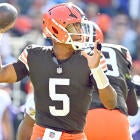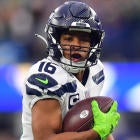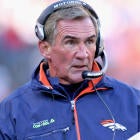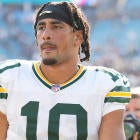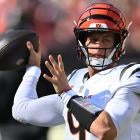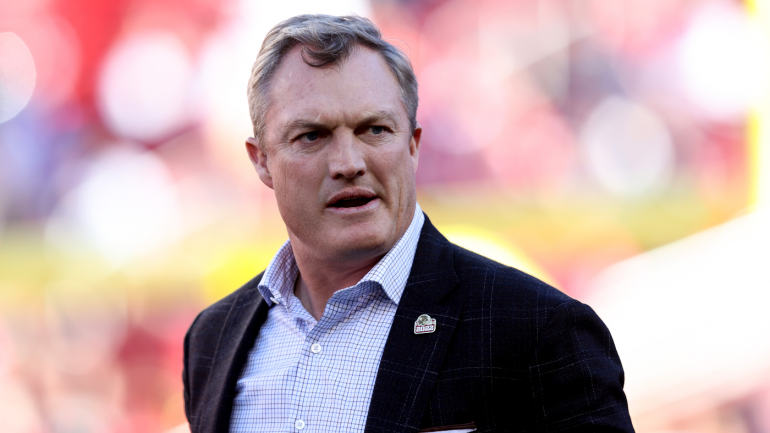
We all agree the NFL is a copycat league. As we approach conference championship Sunday, let's reflect on what the Ravens, Chiefs, 49ers and Lions have taught us about building a championship-caliber team in the modern-day NFL.
Each club was, of course, constructed by different means. But there are common threads between how these franchises were built.
Obtain (and keep) as many draft picks as possible, by any means necessary
The Chiefs and Lions have averaged 7.66 draft picks the past three years. The Ravens, 8.33, and the 49ers three-year average is 8.66 selections.
Kansas City traded Tyreek Hill in his prime after the 2021 season. It netted Chiefs GM Brett Veach five selections, including the Dolphins' 2022 first-rounder.
Detroit traded Matthew Stafford in 2021, got Jared Goff, two first-round picks, and a third.
Baltimore has capitalized on the compensatory pick system unlike any other team. Its 54 compensatory picks since the initiative's inception in 1994 are the most in the NFL. In short, the Ravens replenish their roster with young, cheap talent acquired via the draft instead of always spending big to retain their own free agents.
The 49ers progressive hiring has recently led to a litany of third-round picks they were awarded for former minority employees Mike McDaniel, Ran Carthon, and Martin Mayhew getting jobs elsewhere.
On this front, not even close to all of the picks will be hits. Heck, "hitting" on 30-40% of draft selections is tremendous.
But of course more rolls at the table mean that 30-40% yields more total hits. And vitally, those draft picks are incredibly inexpensive for four seasons, which allows a team to allocate major funds to established veteran stars and superstars.
A GM and his scouting staff are going to have strong convictions on prospects. As they should. But it's vital for teams to temper some of that confidence in their evaluations. Why's that? Because often times overconfidence sparks trade ups that cost valuable draft choices. In short, trade ups should be rare. Trade downs should be common -- and welcomed.
The more picks, the better. These final four teams continue to build evidence to support that stance.
Don't be timid about swinging for the fences
In 2020, the 49ers traded for Trent Williams. Before the 2022 trade deadline, the 49ers sent multiple picks to the Panthers for Christian McCaffrey. In March 2023, San Francisco gave Javon Hargrave $40M fully guaranteed at signing, the highest figure among any free-agent defensive tackle. This past October, they swung an in-season trade to land Chase Young.
All of those transactions happened after the 49ers had George Kittle, Deebo Samuel, and Fred Warner on the roster. And Brandon Aiyuk was drafted in 2020.
May seem backward, but the Chiefs swung for the fence with their idea to trade Hill. Could've easily blown up in their faces. Instead, they won the Super Bowl and are a game away from getting back there again.
The Lions probably felt it was time to turn to a new chapter before they traded Stafford. But it wasn't a lock to happen. They traded for Chauncey Gardner-Johnson in August. While I don't advocate massive trade ups, at least the deal they agreed to with the Vikings in the first round of 2022 to select receiver Jameson Williams included a third-round pick in return, which was used on rotational defensive lineman Joshua Paschal.
And, in a way, to counteract the jump to get Williams, in 2023, armed with two Round 1 selections, Detroit traded back from No. 6 to No. 12 (Jahmyr Gibbs) to obtain No. 34 (Brian Branch), and No. 168 (Brodric Martin). Brilliant.
As for the Ravens, after a painstaking wait, they finally paid Lamar Jackson. Fourth-most total guarantees ($185 million) and third-most fully guaranteed at signing money ($135M) after he'd missed five contests in each of the 2021 and 2022 seasons. They then signed Odell Beckham Jr. to a one-year, $15M deal in early April. The Ravens swung for the fences too.
Always restock the offensive line shelves
Could've gone with prioritizing YAC here, because the 49ers have led the NFL in yards after the catch per reception in each of the past six seasons. And it's now been four-straight regular seasons in which the Chiefs have accumulated the most total YAC in football. But I mention YAC a lot.
This time, I want to pay respects to offensive lines. The backbone of every (great) NFL team.
The Ravens have selected five offensive linemen the past three drafts, including 2022 first-rounder Tyler Linderbaum. Oh, and left tackle Ronnie Stanley is the second-highest paid player on the team by 2023 cap hit.
The Chiefs have spent two Day 2 selections on blockers in the past three drafts and would not be where they are today without the amazing double dip of Creed Humphrey and Trey Smith in the 2021 draft.
San Francisco actually didn't pick an offensive lineman in the 2023 draft but had selected two in each of the previous two years and, yeah, traded for Trent Williams in 2020.
The Lions are the most shining example of offensive line investment in this group with three former first-round picks -- yes, this regime inherited two of them -- up front. They famously erupted when Penei Sewell "fell" to them at No. 7 overall in 2021.
Of course nothing's more important than a quarterback. But an offensive line has a strong argument as the second-most critical element to a functional offense. The Ravens, Chiefs, 49ers, and Lions exemplify that.










